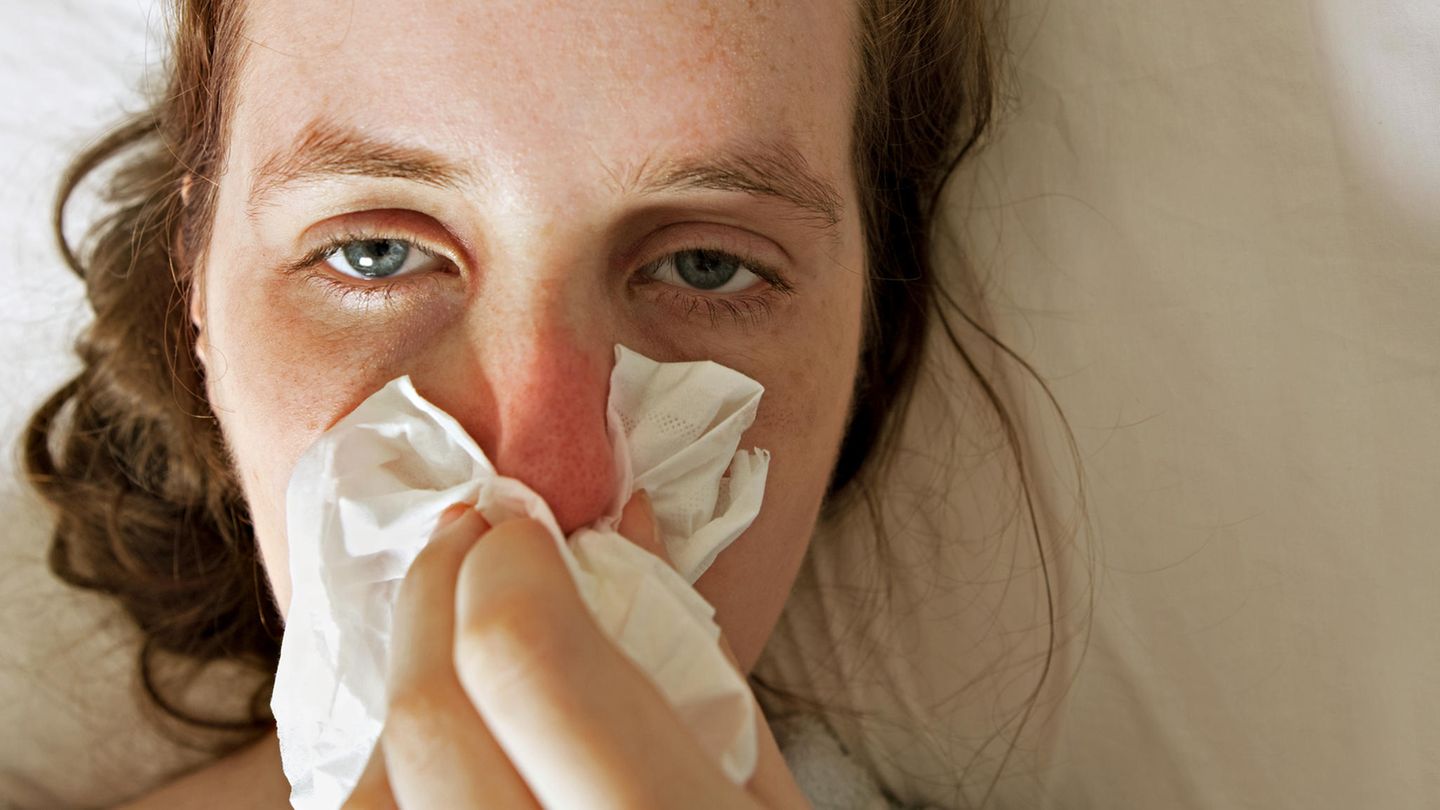Sniff!
Sore nose with a cold? These tricks help
Copy the current link
When you have a cold, your nose is often affected not only on the inside but also on the outside. An expert reveals what helps against painful redness.
Your nose runs and runs, you sneeze and can hardly keep up with cleaning. As if the cold alone wasn’t annoying enough, to make matters worse, sometimes the skin around the entrance to the nose and up to the upper lip also becomes red and sore. This can not only be uncomfortable, but also painful.
However, such irritation does not always occur. Several factors can contribute to the fact that the cold is not just limited to the inside of the nose. One of them: the secretion.
It is formed in the nose, more precisely in the mucous membrane that lines the entire inside of the nose, including the paranasal sinuses. This mucous membrane has an important function: it cleans the respiratory tract and frees it from harmful substances that are inhaled in the air, such as dirt particles or pathogens. The secretion binds these particles and pathogens and ensures that they are transported away, backwards into the throat or forwards to the nasal exit. A process that is usually hardly noticeable. It only becomes clear when you have a cold because the inflamed mucous membrane swells and produces much more secretion than usual – the stronger the cold, the more.
Only tissues, no kitchen roll
It is mainly this constant flow and the frequent blowing of the nose that makes the nose red and sore. “The secretion itself consists of proteins, pathogens and their degradation products,” says Karen Krüger in Berlin-Mitte. “It irritates the nose with constant contact.” Frequent brushing and rubbing increases the effect.
Sore throat, diarrhea, sleep disorders: you should know these seven home remedies
Home remedy for a sore throat: sage tea
The name of the sage plant comes from the Latin word “salvare”, meaning to heal. In fact, the plant has an antibacterial effect and inhibits the growth of viruses and fungi. In addition to the antiseptic effect, there are decongestant and vascular sealing properties, and the thujone contained in the essential oil has a pain-relieving effect. The experts from Commission E, an expert committee for herbal medicines, therefore recommend gargling with sage tea for mouth and throat infections.
Recipe
➝ Pour half a liter of boiling water over a teaspoon of dried sage leaves.
➝ Let it steep for ten minutes and drain the tea.
➝ Gargle with it several times a day until the symptoms subside.
© vicuschka / Getty Images
Back
Further
But that doesn’t mean you have to give up tissues; Neither pulling yourself up nor snorting on the ground, as you often see athletes do, are particularly socially acceptable. So all that’s left is the handkerchief – but that’s what it should be. “Many people quickly reach for kitchen roll or toilet paper when their nose is running. That’s not a good thing, because these papers often have a much coarser structure and attack the sensitive area even more,” says Krüger. As for the texture of the tissues: the normal ones are soft enough. No other additives such as aloe vera or chamomile are needed. Krüger completely advises against using tissues containing menthol. The essential oils could further irritate the skin.
It’s better to dab instead of rubbing
If you want to avoid a red, sore nose, you should be gentle, especially when brushing: “It’s best to just dab your nose and avoid rubbing and snorting too hard,” says Krüger. If the skin around the nose is already red and damaged, the doctor recommends caring for the area with a special nasal ointment, such as one that contains the active ingredient panthenol. This can primarily be used to treat the affected mucous membrane, but the skin at the entrance to the nose is also soothed and the redness can heal. The ointment can also be applied preventatively, inside and outside.
According to Krüger, other creams are not suitable, especially for the nasal mucosa: neither unscented, fatty care creams nor baby wound creams, as is often recommended in forums on the Internet, are helpful. “Firstly, wound creams hardly stick,” says Krüger, “and secondly, like normal care creams, they are only intended for external use on the skin. They are too aggressive for the nasal mucosa.” This already has enough to do with warding off the pathogens.
Cold: Rinsing your nose and inhaling helps
In general, anything that helps the nasal mucosa to regenerate as quickly as possible is good for a sore nose. Even if it takes a few days to get over the annoying sniffling, snorting and sneezing, there are a few things you can do to alleviate the symptoms. If the mucous membrane is very swollen, doctors usually recommend decongestant nasal drops to ventilate the nose and sinuses again and allow accumulated secretions to drain away. However, they may only be used for a maximum of five days at a time to avoid habituation.
In addition, proven measures such as inhaling or rinsing the nose with a saline solution help. Like the ointments, they help to keep the environment in the nose moist so that the mucous membrane can fulfill its protective effect. Pure seawater nasal sprays also serve the same purpose, albeit to a lesser extent, and can be used to moisten in between or on the go. Another problem is that the mucous membranes, like the skin, dry out very quickly in dry, air-conditioned rooms. Especially then they become sore and cracked – and even more susceptible to irritation and infections.
The article was updated in December 2024.
Source: Stern
I’m Caroline, a journalist and author for 24 Hours Worlds. I specialize in health-related news and stories, bringing real-world impact to readers across the globe. With my experience in journalism and writing in both print and online formats, I strive to provide reliable information that resonates with audiences from all walks of life.





